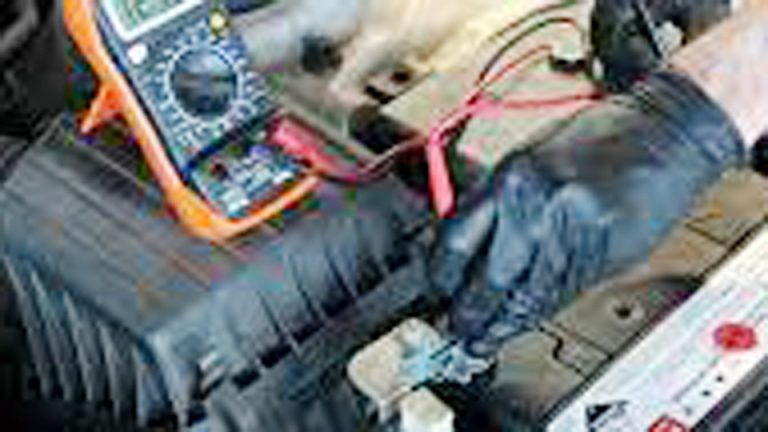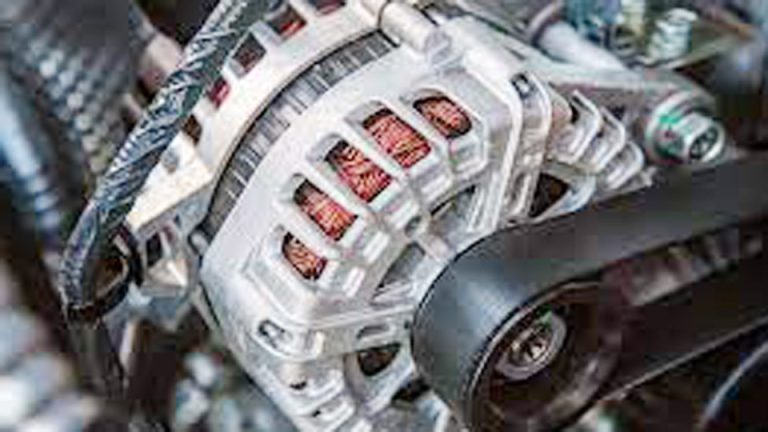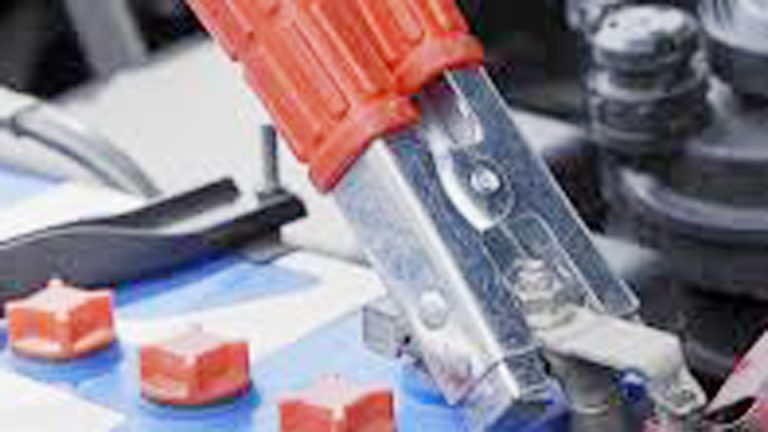One of the most common garage myths I hear is: “Why Is It Bad to Store Car Batteries on Cement Floors?” For years, people have believed that setting a battery directly on concrete would cause it to discharge or go bad. That was true decades ago when batteries were made with rubber cases and less reliable seals—moisture from the concrete could seep in, or the casing could allow a slow drain. But modern batteries are built with durable plastic housings that prevent that problem entirely.
So, is it really bad today? Not exactly. The concrete itself won’t magically drain your battery, but there are still a few reasons I avoid leaving one on the floor. For starters, cement tends to be colder than the surrounding air, and those temperature swings can reduce a battery’s charge over time. On top of that, leaving a heavy battery on a hard surface risks scuffs, dirt buildup on the terminals, or even a crack if it’s accidentally knocked over.
In my shop, I always place batteries on a wooden block, cardboard, or a proper storage tray. It’s a simple precaution that keeps them clean, stable, and at a more consistent temperature—so they last longer and are ready when you need them.

Image by reddit
What Is a Car Battery and Why Does It Matter?
Role of a Car Battery
A car battery is a rechargeable lead-acid or lithium-ion power source that delivers the juice to start your engine and run electrical components when the alternator isn’t spinning. It’s like the coffee that gets your car out of bed in the morning. Most vehicles in the U.S. use 12-volt lead-acid batteries, with sizes and specs varying based on the make and model—think Group 24 for a Honda Civic or Group 65 for a Ford F-150.
Why does it matter? A healthy battery ensures your car starts reliably, powers accessories like your radio or heated seats, and stabilizes voltage to protect sensitive electronics. A dead or failing battery can leave you stranded, damage your alternator, or even cause electrical fires in rare cases. Proper storage is key to maintaining its charge and longevity, especially if you’re keeping a spare for a classic car or seasonal vehicle.
Common Problems with Car Batteries
Batteries aren’t invincible. From my time in the shop, I’ve seen batteries fail due to:
- Sulfation: Lead sulfate crystals build up on the plates, reducing capacity. This happens when a battery sits discharged for too long.
- Self-Discharge: All batteries lose charge over time, especially in extreme heat or cold.
- Corrosion: Acid leaks or terminal buildup can weaken connections.
- Physical Damage: Cracks or leaks from improper handling or storage.
I once had a customer bring in a battery that looked like it had been used as a doorstop. It was cracked, leaking, and dead as a doornail. He’d stored it on his garage floor for months, thinking it was fine. That’s a classic mistake we’ll cover later.
When and Why Replacement Is Needed
Batteries typically last 3–5 years, depending on climate, driving habits, and maintenance. In hot states like Arizona, I’ve seen batteries die in under two years due to heat accelerating chemical breakdown. You’ll know it’s time to replace your battery if:
- Your car cranks slowly or not at all.
- The battery warning light pops on.
- You measure voltage below 12.4 volts with a multimeter when the car is off.
- The battery case is swollen or cracked.
Replacement isn’t just about getting your car started—it’s about preventing strain on your alternator and starter, which can cost hundreds to replace. A good battery also improves fuel efficiency by reducing the alternator’s workload.
The Cement Floor Myth: Where It Came From and the Truth
The Origin of the Myth
Back in the 1950s, car batteries had cases made of hard rubber or tar-like materials that weren’t fully sealed. When placed on a cold, damp concrete floor, condensation could form, and the porous cases sometimes allowed electrolyte to leak, creating a path for discharge. Old-timers noticed batteries dying faster and blamed the cement. It wasn’t entirely wrong back then, but times have changed.
Modern batteries use sealed polypropylene cases that are far less permeable. I’ve tested this myself—left a brand-new Interstate battery on my garage floor for six months, and it held its charge just fine when hooked to a maintainer. The cement floor itself doesn’t “suck” the charge out, but there are still reasons to avoid storing batteries directly on concrete.
Why It’s Still a Bad Idea
While cement won’t directly drain your battery, it can cause issues:
Temperature Extremes: Concrete floors in garages or shops often stay cold, especially in winter. Cold temperatures slow the chemical reactions inside a battery, reducing its capacity temporarily and accelerating self-discharge if not maintained.
Moisture: Unsealed concrete can trap moisture, leading to corrosion on battery terminals or even case damage over time.
Vibration and Stability: A concrete floor is unforgiving. Dropping a battery or exposing it to vibrations (say, from nearby machinery) can crack the case or loosen internal plates.
I learned this the hard way when a buddy stored a battery on his shop floor near a running compressor. The vibrations shook the battery enough to cause a small crack, leaking acid and ruining his day. Elevating batteries on a wooden shelf or rubber mat is a simple fix.
OEM vs Aftermarket Batteries: Which Should You Choose?
OEM Batteries: What You Get
Original Equipment Manufacturer (OEM) batteries come from the carmaker—think Mopar for Chrysler or Motorcraft for Ford. They’re designed to meet your vehicle’s exact specs for size, cold cranking amps (CCA), and reserve capacity (RC).
Pros:
- Guaranteed compatibility with your vehicle.
- Often backed by a dealership warranty (1–3 years).
- High-quality construction from brands like East Penn or Johnson Controls.
Cons:
- Expensive—often $150–$250 for popular models like a Toyota Camry or Chevy Silverado.
- Limited availability outside dealerships.
- Not always the best value for older vehicles.
I’ve installed OEM batteries in late-model cars like a 2020 Honda Accord, and they’re rock-solid but pricey. If your car’s under warranty, stick with OEM to avoid voiding coverage.
Aftermarket Batteries: Options and Considerations
Aftermarket batteries come from third-party brands like Interstate, DieHard, or Optima. They’re widely available at auto parts stores like AutoZone or O’Reilly and often offer more variety in terms of performance and price.
Pros:
- More affordable—$80–$150 for most standard batteries.
- Wider selection, including AGM (Absorbed Glass Mat) for high-performance or stop-start vehicles.
- Easy to find at retailers or online (e.g., Walmart, Amazon).
Cons:
- Quality varies by brand. Cheap no-name batteries can fail in under a year.
- May not match OEM specs perfectly, affecting performance in some vehicles.
- Shorter warranties (1–2 years free replacement vs. OEM’s longer prorated terms).
I’ve had great luck with Interstate and Optima AGM batteries for trucks and SUVs, especially in cold climates where CCAs matter. For a daily driver like a Nissan Altima, a mid-tier DieHard works fine and saves you $50 over OEM.
Comparison Table: OEM vs. Aftermarket Batteries
| Feature | OEM | Aftermarket |
|---|---|---|
| Price | $150–$250 | $80–$150 |
| Warranty | 1–3 years, often prorated | 1–2 years, some prorated |
| Compatibility | Exact match for vehicle | Varies, check group size/CCAs |
| Availability | Dealerships, limited retail | Auto parts stores, online |
| Best For | New cars, warranty concerns | Older cars, budget-conscious |
My Take
For a newer car or one under warranty, go OEM to play it safe. For a 10-year-old beater or a project car, aftermarket brands like Interstate or DieHard Gold are plenty reliable and won’t break the bank. Always check your vehicle’s group size (e.g., 24F, 35, H6) and CCA requirements in the owner’s manual before buying.
How to Store a Car Battery Properly
Why Proper Storage Matters
Storing a battery wrong can cut its lifespan in half. A neglected battery can sulfate, lose charge, or even become a safety hazard if acid leaks. I’ve seen customers bring in batteries they “stored” in a damp garage corner, only to find them corroded and useless. Proper storage keeps your battery ready for action and saves you from buying a new one prematurely.
Step-by-Step Guide to Battery Storage
Fully Charge the Battery: Use a smart charger (like a NOCO Genius) to bring it to 12.6–12.8 volts. A partially charged battery is more likely to sulfate.
Clean the Terminals: Wipe off corrosion with a baking soda-water mix and a wire brush. I keep a cheap toothbrush in my toolbox just for this.
Store in a Stable Environment: Aim for 50–70°F. Avoid garages that hit 100°F in summer or freeze in winter. A basement shelf works great.
Elevate It: Place the battery on a wooden board, rubber mat, or plastic shelf—not directly on concrete. This reduces moisture exposure and vibration damage.
Use a Battery Maintainer: Hook up a trickle charger (1–2 amps) to keep the battery topped off. I use a Battery Tender Jr. for my project car’s battery.
Check Monthly: Test voltage with a multimeter. If it drops below 12.4 volts, recharge immediately.
Avoid Sparks and Flames: Store away from gas cans or welders. Battery acid is flammable if it leaks.
Common Storage Mistakes
- Storing Discharged: A dead battery sulfates fast. I had a customer store a half-charged battery for a winter, and it wouldn’t hold a charge by spring.
- Ignoring Corrosion: Dirty terminals can cause slow discharge or poor connections when reinstalled.
- Extreme Temperatures: Don’t leave batteries in unheated sheds or scorching attics. Heat kills batteries faster than cold.
- Stacking Batteries: Stacking can crack cases or short-circuit terminals. Always store upright and isolated.
Tools You’ll Need
- Multimeter: To check voltage ($20 at Harbor Freight).
- Smart Charger/Maintainer: NOCO or Battery Tender ($30–$60).
- Wire Brush and Baking Soda: For cleaning terminals ($5).
- Non-Conductive Shelf or Mat: Wood or rubber to elevate the battery.
How to Spot Genuine vs Fake Batteries
The Risk of Counterfeit Batteries
Counterfeit batteries are a real problem, especially when buying online or from shady retailers. I once bought a “deal” on an Optima battery from a sketchy eBay seller, only to find it was a knockoff with half the advertised CCAs. Fake batteries can fail early, damage your car, or even leak acid.
Signs of a Genuine Battery
Branding and Packaging: Look for clear logos, serial numbers, and professional packaging. Brands like Interstate or Duralast have holographic stickers or QR codes.
Weight: Real batteries are heavy due to lead plates. A suspiciously light battery is a red flag.
Retailer Reputation: Stick to trusted stores like AutoZone, Advance Auto, or Walmart. For online, check Amazon’s “Sold by” details.
Warranty Paperwork: Genuine batteries come with clear warranty terms and a receipt. Counterfeits often lack documentation.
Price Check: If a $150 battery is listed for $50, it’s likely fake. Compare prices on manufacturer websites.
Tips to Avoid Fakes
- Buy from authorized dealers or directly from brands like Interstate or Optima.
- Check reviews and seller ratings on platforms like Amazon.
- Test the battery’s voltage and CCA at a shop if you’re unsure. Most auto parts stores do this for free.
Installation Tips and Maintenance Best Practices
Installing a Car Battery
Swapping a battery is straightforward but requires care. I’ve seen DIYers fry electronics by crossing terminals or forgetting to disconnect the negative cable first. Here’s how to do it right:
- Safety First: Wear gloves and safety glasses. Batteries can leak acid or spark.
- Turn Off the Car: Ensure the ignition and all electronics are off.
- Disconnect the Negative Terminal: Use a 10mm or 12mm wrench to loosen the negative (-) cable first to prevent shorts.
- Remove the Positive Terminal: Disconnect the positive (+) cable next.
- Remove the Battery: Undo any hold-down clamps and lift carefully—it’s heavy (30–50 lbs).
- Clean the Tray and Terminals: Use a wire brush and baking soda solution to remove corrosion.
- Install the New Battery: Place it in the tray, secure the clamp, and connect the positive terminal first, then the negative.
- Test It: Start the car and check voltage (13.8–14.4 volts with the engine running).
Maintenance Tips
- Check Terminals Monthly: Tighten loose connections and clean corrosion.
- Monitor Voltage: A resting battery should read 12.6–12.8 volts. Below 12.4 volts means it needs charging.
- Avoid Short Trips: Short drives don’t let the alternator fully charge the battery. Take a 20-minute highway drive weekly if you can.
- Use a Maintainer for Long-Term Storage: Keeps the battery healthy without overcharging.
Common Installation Mistakes
- Crossing Terminals: Hooking positive to negative can fry your car’s electronics. Double-check before tightening.
- Not Securing the Battery: A loose battery can vibrate and crack. Always use the hold-down clamp.
- Ignoring Corrosion: Dirty terminals reduce performance. Clean them before installing.
Real-World Anecdotes from the Garage
I’ll never forget the time a customer rolled into my shop with a 2005 Chevy Tahoe that wouldn’t start. He’d stored his battery on the garage floor all winter, thinking it was fine because “it’s just concrete.” The terminals were caked in corrosion, and the battery was down to 11.2 volts—basically a paperweight.
We cleaned it up, charged it, and got it working, but it was a wake-up call for him about proper storage. Another time, a buddy of mine swore his classic Mustang’s battery died because of a cement floor. Turned out, he’d left it discharged for months without a maintainer. Old myths die hard, but a little knowledge goes a long way.
Smarter Battery Storage and Buying Decisions
Storing car batteries on cement floors isn’t the death sentence it used to be, but it’s still not the best idea. Cold, damp concrete can accelerate discharge, promote corrosion, and invite physical damage. Elevate your battery, keep it charged, and store it in a stable environment to maximize its life.
Whether you’re a DIYer or a pro, choosing the right battery—OEM for newer cars, quality aftermarket for older ones—saves time and money. Always check for genuine parts, follow proper installation steps, and maintain your battery regularly.
Pro Tip: Invest in a $30 battery maintainer. It’s cheaper than replacing a $100 battery every couple of years. Keep it plugged in during storage, and you’ll thank yourself when your car starts on the first try.
FAQ: Common Car Battery Questions
Why Does My Car Battery Keep Dying?
A battery can die from frequent short trips, extreme temperatures, or parasitic drains (like a faulty radio or alarm). Test it with a multimeter and check for corrosion or loose connections. If it’s over 3 years old, consider replacing it.
How Long Should a Car Battery Last?
Most batteries last 3–5 years. Hot climates (e.g., Texas, Arizona) can cut life to 2 years, while cooler areas may stretch it to 5–6. Regular maintenance and a charger extend lifespan.
Can I Store a Car Battery in My House?
Yes, but store it in a cool, dry place like a basement, away from heat sources or kids. Use a plastic container to catch any leaks and hook it to a maintainer.
What’s the Best Battery Brand for My Car?
Interstate, Optima, and DieHard are solid aftermarket choices. For OEM, stick with what your carmaker recommends (e.g., Motorcraft for Ford). Match the group size and CCA to your vehicle.
How Do I Know If My Battery Is Genuine?
Check for clear branding, serial numbers, and proper weight. Buy from reputable retailers like AutoZone or directly from the manufacturer. If the price seems too good to be true, it probably is.



